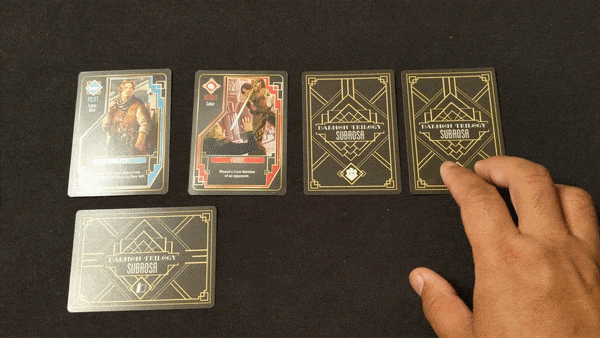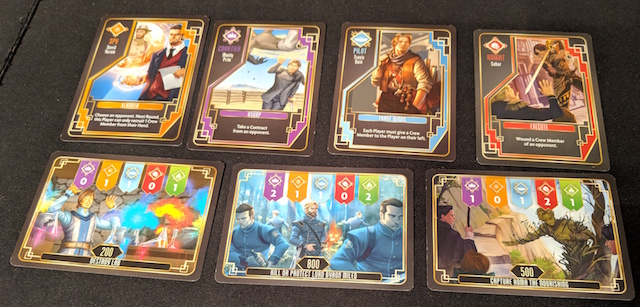On the Tabletop is an ongoing series of board game overviews featuring my thoughts on the latest tabletop products.
In Daemon Trilogy: Subrosa players are leaders of the five noble houses trying to recruit mercenaries to complete various contracts. The game is card drafting and set collection game at its heart, with a fair amount of player interaction based on the cards being played, and players score points based on their completed contracts.
Players begin with a hand of 15 cards and 1-3 contracts. Each round of play consists of five phases.
- Recruitment Phase: each player places two cards facedown in front of them. This is their “crew.”
- Action Phase: players may select one crew member to to activate by pushing it forward. Optionally, a player may instead take two contracts, discarding any one contract.
- Resolution Phase: players resolve their activated characters in turn order. Even if a character is wounded, their ability will resolve before they’re removed from the game.
- Scoring Phase: players may complete any contracts by revealing the required crew members (cards in hand do not count towards contracts). Completed contracts and the cards used to complete them are removed from the game.
- Passing Phase: all players pass their hand of cards to the left.
The game ends immediately when at least one player has zero or one cards in their hand at the end of a round. Players add the total of their completed contracts, then subtract half the value of their incomplete contracts. For example, if a player has one incomplete contract worth 400 points, then they would subtract 200 points. The player with the most points wins.
Daemon Trilogy: Subrosa is a top-notch production, from the terrific artwork to the linen-finish cards. It’s a good filler game, with tactical decisions made every round. Since you’re passing your hand each round, you can’t just hoard the cards you need for your contracts. You’ll have to be flexible in your strategy and will need to adapt as you activate your cards and react to your opponents’ activations. Do you try to complete a smaller contract as soon as possible or do you go for the big points while possibly passing cards that your opponents need?
There’s a backstory to the game as given in the rulebook, but it doesn’t affect gameplay at all. I am curious, though, to see what the next games are in the Daemon Trilogy and see if/how it expands on Subrosa.
Final note: there’s an app for the game that’s supposed to enhance game play, but it was buggy when I gave it a test run and I didn’t bother to include it when actually playing the game. Hopefully, they’ll update it soon for a smoother experience.
Thanks to IDW Games for providing this copy of Daemon Trilogy: Subrosa.


